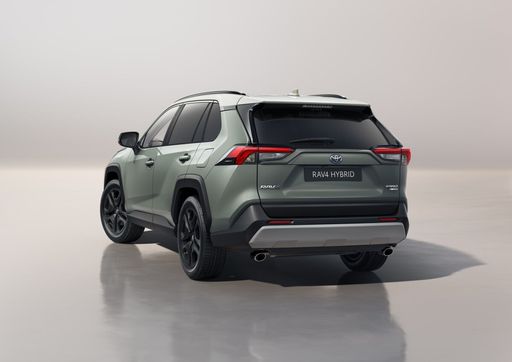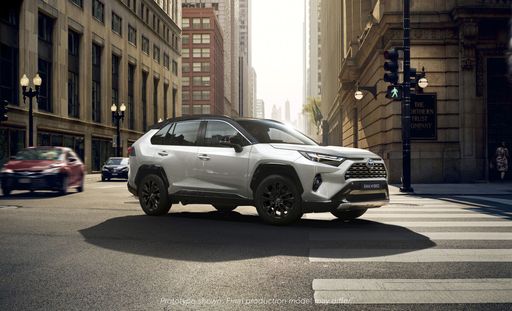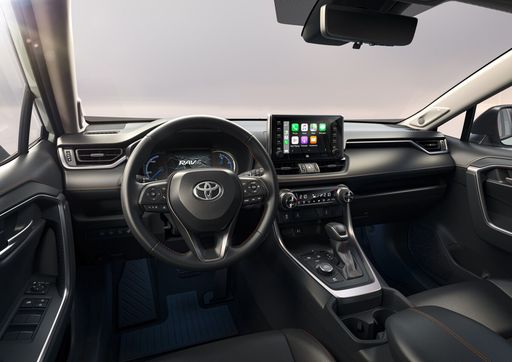Toyota RAV4 vs Kia PV5 - Unterschiede & Preise im Vergleich
Vergleiche Leistung, Kofferraum, Verbrauch und Preis auf einen Blick.
Finde jetzt heraus, welches Auto für dich die bessere Wahl ist, Toyota RAV4 oder Kia PV5?
Der Toyota RAV4 (SUV) kommt mit einem Voll Hybrid oder Plugin Hybrid-Motor und Automatik Getriebe. Im Vergleich dazu ist der Kia PV5 (Transporter oder Bus) mit einem Elektro-Motor und Automatik Getriebe ausgestattet.
Beim Kofferraumvolumen bietet der Toyota RAV4 580 L und der Kia PV5 1320 L – je nachdem, wie viel Platz du brauchst. Wer mehr Leistung sucht, muss wählen ob die 306 PS des Toyota RAV4 oder die 163 PS des Kia PV5 für die eigenen Bedürfnisse genügen.
Beim Verbrauch liegen die Werte bei 1 L pro 100 km für den Toyota RAV4 und 19.80 kWh für den Kia PV5.
Preislich startet der Toyota RAV4 ab 41000 €, während der Kia PV5 ab 38300 € erhältlich ist. Vergleiche alle Details und finde heraus, welches Modell besser zu deinem Leben passt!
Toyota RAV4
Der Toyota RAV4 beeindruckt mit seinem dynamischen Design und dem vielseitigen Gesamtkonzept, das sowohl für Städter als auch für Outdoor-Enthusiasten attraktiv ist. Mit seiner durchdachten Raumaufteilung und hochwertigen Innenraummaterialien sorgt der kompakte SUV für ein angenehmes Fahrerlebnis auf allen Strecken. Darüber hinaus überzeugt der RAV4 durch seine zuverlässige Performance und fortschrittliche Sicherheitstechnologien, die ein hohes Maß an Fahrkomfort garantieren.
Details @ Toyota
@ Toyota
 @ Toyota
@ Toyota
 @ Toyota
@ Toyota
 @ Toyota
@ Toyota
Kia PV5
The Kia EV5 is an exciting new entrant in the landscape of electric SUVs, promising a blend of style and innovation that captures attention. It boasts a sleek and modern design that aligns with Kia's evolving aesthetic identity, blending practicality with eye-catching details. With its foray into the electric vehicle segment, the EV5 is set to offer a highly competitive option for those looking to embrace sustainable mobility without compromising on comfort or tech features.
Details

|
|
|
|
|
Kosten und Verbrauch |
|
|---|---|
|
Preis
41000 - 65000 €
|
Preis
38300 - 45400 €
|
|
Verbrauch L/100km
1 - 5.6 L
|
Verbrauch L/100km
-
|
|
Verbrauch kWh/100km
-
|
Verbrauch kWh/100km
19.8 - 20.3 kWh
|
|
Elektrische Reichweite
75 km
|
Elektrische Reichweite
288 - 400 km
|
|
Batteriekapazität
-
|
Batteriekapazität
51.5 - 71.2 kWh
|
|
co2
22 - 128 g/km
|
co2
0 g/km
|
|
Tankgröße
55 L
|
Tankgröße
-
|
Maße und Karosserie |
|
|---|---|
|
Karosserie
SUV
|
Karosserie
Transporter, Bus
|
|
Sitze
5
|
Sitze
2 - 5
|
|
Türen
5
|
Türen
4 - 5
|
|
Leergewicht
1745 - 1910 kg
|
Leergewicht
1860 - 2145 kg
|
|
Kofferraum
520 - 580 L
|
Kofferraum
1320 L
|
|
Länge
4600 mm
|
Länge
4695 mm
|
|
Breite
1855 mm
|
Breite
1850 - 1895 mm
|
|
Höhe
1685 mm
|
Höhe
1923 mm
|
|
Zuladung
390 - 600 kg
|
Zuladung
505 - 790 kg
|
Motor und Leistung |
|
|---|---|
|
Motorart
Voll Hybrid, Plugin Hybrid
|
Motorart
Elektro
|
|
Getriebe
Automatik
|
Getriebe
Automatik
|
|
Getriebe Detail
CVT-Getriebe
|
Getriebe Detail
Reduktionsgetriebe
|
|
Antriebsart
Frontantrieb, Allrad
|
Antriebsart
Frontantrieb
|
|
Leistung PS
218 - 306 PS
|
Leistung PS
121 - 163 PS
|
|
Beschleunigung 0-100km/h
6 - 8.4 s
|
Beschleunigung 0-100km/h
10.7 - 16.3 s
|
|
max. Geschwindigkeit
180 km/h
|
max. Geschwindigkeit
135 km/h
|
|
Drehmoment
-
|
Drehmoment
250 Nm
|
|
Anzahl Zylinder
4
|
Anzahl Zylinder
-
|
|
Leistung kW
160 - 225 kW
|
Leistung kW
89 - 120 kW
|
|
Hubraum
2487 cm3
|
Hubraum
-
|
Allgemein |
|
|---|---|
|
Modelljahr
2024 - 2025
|
Modelljahr
2025
|
|
CO2-Effizienzklasse
D, B
|
CO2-Effizienzklasse
A
|
|
Marke
Toyota
|
Marke
Kia
|
Toyota RAV4
Der Toyota RAV4: Ein Meisterstück der SUV-Innovation
Der Toyota RAV4 hat sich als eines der beliebtesten SUVs auf dem Markt etabliert. Mit seinem modernen Design, beeindruckender Technik und umweltbewussten Antrieben bietet er Fahrspaß und Vielseitigkeit gleichermaßen. In diesem Beitrag werfen wir einen genaueren Blick auf die technischen Details und Innovationen, die den Toyota RAV4 auszeichnen.
Effiziente Antriebe für jeden Bedarf
Der Toyota RAV4 ist mit zwei innovativen Antriebsvarianten erhältlich: dem Voll-Hybrid und dem Plug-In-Hybrid. Der Voll-Hybrid kombiniert einen Benzinmotor mit einem Elektromotor, was eine Gesamtleistung von bis zu 222 PS ermöglicht. Für jene, die noch mehr elektrische Effizienz suchen, bietet der Plug-In-Hybrid mit beeindruckenden 306 PS und einer elektrischen Reichweite von bis zu 75 km eine flexible Alternative.
Technik, die begeistert
Der RAV4 ist mit einem CVT-Getriebe ausgestattet, das für sanfte Schaltvorgänge sorgt. Die CO2-Effizienzklasse reicht von B bis D, was zeigt, dass der Toyota RAV4 trotz seiner starken Leistung umweltfreundlich ist. Der Verbrauch liegt zwischen 1 und 5.6 Litern pro 100 km, abhängig von der Antriebsvariante, und unterstreicht das effiziente Design des Fahrzeugs.
Ein SUV, das Platz und Komfort bietet
Mit einer Länge von 4600 mm und einem Kofferraumvolumen zwischen 520 und 580 Litern bietet der RAV4 großzügigen Raum für Familie und Gepäck. Das Modell ist standardmäßig mit fünf Türen und einem Gewicht zwischen 1745 und 1910 kg ausgestattet. Die hochwertige Ausstattungslinie reicht von der sportlichen „GR SPORT AWD-i“ bis zur komfortablen „Lounge“ Variante, sodass jeder Fahrer seine bevorzugte Balance aus Stil und Funktion findet.
Sicherheit und Zuverlässigkeit an erster Stelle
Der Toyota RAV4 legt großen Wert auf Sicherheit und Zuverlässigkeit. Mit Allrad- und Frontantriebsoptionen bietet er selbst bei schwierigen Straßenverhältnissen hohe Stabilität. Hochmoderne Sicherheitsfeatures sorgen dafür, dass sowohl Fahrer als auch Passagiere sich stets gut aufgehoben fühlen.
Abschließend lässt sich sagen, dass der Toyota RAV4 eine ausgezeichnete Wahl für Kunden ist, die ein zuverlässiges, kraftstoffeffizientes und komfortables SUV suchen. Seine innovativen Technologien, vereint mit der bekannten Qualität von Toyota, machen ihn zu einer überlegenswerten Option in seinem Segment.
Kia PV5
A Fresh Perspective on Cargo Vans: The Kia PV5
The Kia PV5 stands as a beacon of innovation in the realm of electric cargo vans. Known for its forward-thinking design and practicality, this model sets a new standard in its class. The PV5 combines cutting-edge technology with an eco-friendly design, redefining the expectations for businesses seeking sustainable transportation solutions.
Electric Power Meets Efficiency
At the heart of the Kia PV5 lies an advanced electric powertrain. The model is equipped with a 51.5 kWh battery, offering an impressive electric range of 291 km on a single charge. This robust power supply pairs with a front-wheel-drive system powered by an electric motor that delivers 121 HP (equivalent to 89 kW), keeping the operations both smooth and efficient.
Sustainability Without Compromise
The commitment to sustainability is evident in the PV5’s zero emissions, with a CO2 output of 0 g/km. The van maintains a CO2 Efficiency Class of A, clearly demonstrating Kia’s dedication to reducing the environmental impact of its vehicles. Businesses adopting the PV5 can confidently promote their green credentials while benefiting from the cost savings associated with electric driving.
Designed for Modern Business Needs
The Kia PV5 Cargo L2H1 Electric Automatic model is engineered for functionality and ease of use. Its spacious design accommodates two seats and offers a generous cargo area, making it perfect for diverse delivery needs. The van spans 4695 mm in length, 1850 mm in width, and 1923 mm in height, providing ample space to maneuver goods with ease.
Performance and Practicality
In terms of performance, the PV5 boasts a torque of 250 Nm and can accelerate from 0 to 100 km/h in 16.3 seconds. While its top speed is capped at 135 km/h, this is more than sufficient for urban and suburban delivery routes. The reduction gearbox ensures smooth transitions as it navigates through daily tasks.
Safety and Innovation
Safety is not compromised with the Kia PV5. It features a suite of safety technologies that support the driver in maintaining control and avoiding incidents. These innovations not only contribute to the safety of the driver and cargo but also offer peace of mind to businesses that prioritize the wellbeing of their workforce and goods.
The Road Ahead for Kia PV5
As the automotive industry continues to move towards electrification, the Kia PV5 exemplifies how cargo vans can adapt to this change seamlessly. It represents an essential step towards more sustainable business operations, providing a viable and efficient option for companies looking to reduce their carbon footprint while enhancing operational efficiency. The Kia PV5 is more than just a vehicle; it’s a strategic asset for any forward-thinking business.
Gibt es verschiedene Antriebe beim Toyota RAV4?
Verfügbar als Frontantrieb oder Allrad.
Die angezeigten Preise und Daten sind Schätzungen, die auf deutschen Listenpreisen basieren, und können je nach Land variieren. Diese Informationen sind rechtlich nicht bindend.
